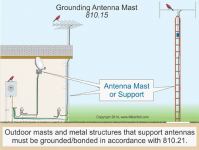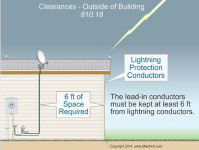Ok... It's possible I'm not expressing myself clearly.
My idea is that in a 240 Volt home power system, if there is an imbalance in loads between the two phases (although I guess it's technically called a single phase system.) The imbalance goes to the neutral, which is connected to the ground at the entry panel.
Shouldn't there be be some sort of current on the ground system, although most should go to the neutral back to the transformer? AND if there is another grounded system nearby, there should be a potential difference that could be exploited?
The second part of my "issues" (in a nice sense "issues") is that The N.E.C. says that the down-lead on the mast (which should have a lightning rod) can't be near the feed-line, which is just about impossible for most of us.
Maybe I'm just brain blocking the understanding of having to keep the feed-line and ground separated by a distance that isn't practical.
These two illustrations shows the general idea, a lightning down-conductor would be right next to the feedline on the mast (the TV looking one).


Thanks to Mike Holt for the illustrations.
Joel
My idea is that in a 240 Volt home power system, if there is an imbalance in loads between the two phases (although I guess it's technically called a single phase system.) The imbalance goes to the neutral, which is connected to the ground at the entry panel.
Shouldn't there be be some sort of current on the ground system, although most should go to the neutral back to the transformer? AND if there is another grounded system nearby, there should be a potential difference that could be exploited?
The second part of my "issues" (in a nice sense "issues") is that The N.E.C. says that the down-lead on the mast (which should have a lightning rod) can't be near the feed-line, which is just about impossible for most of us.
Maybe I'm just brain blocking the understanding of having to keep the feed-line and ground separated by a distance that isn't practical.
These two illustrations shows the general idea, a lightning down-conductor would be right next to the feedline on the mast (the TV looking one).


Thanks to Mike Holt for the illustrations.
Joel


